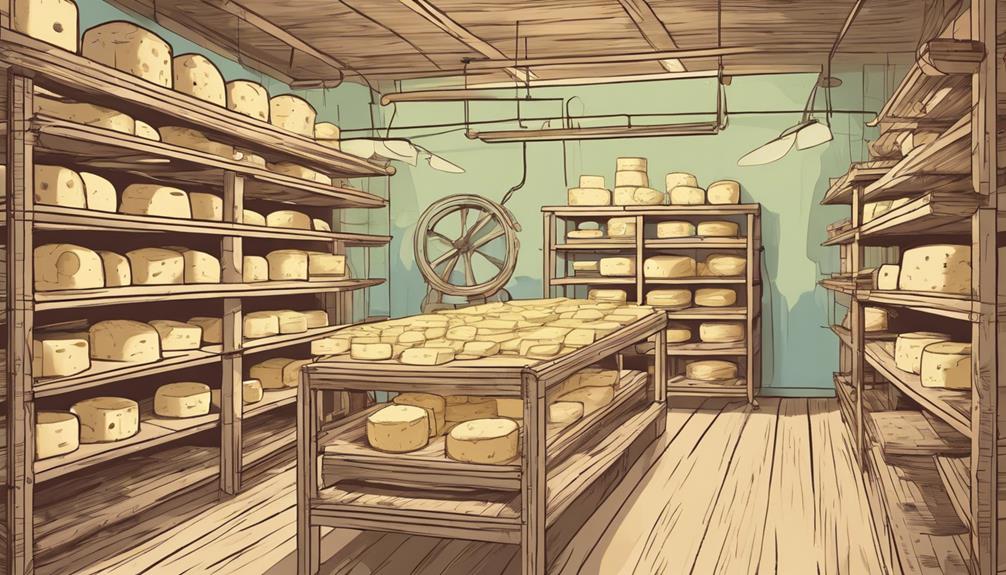How To Become More Self-Sufficient Without Starting a Full-Blown Farm…
Want to start preserving your harvest, making your own soap, or building a backyard root cellar — but not sure where to begin? “Homesteading Advice” gives you instant lifetime access to 35+ practical homesteading books on food preservation, veggie gardening, DIY natural cleaning products (save over $250 per year with this skill alone), brewing, off-grid energy, and a whole lot more…
Click Here To Check It Out Now!
“Hey! I recently started using a natural cave on my property in Boulder, Colorado to age my cheeses. I want to make sure everything is done safely and correctly. What are some safety measures I should take while using this natural aging environment?” Thanks a lot, Kenneth, Boulder, USA.
What Are The Safety Measures For Using Natural Aging Environments?
Hey Kenneth! That’s such a cool venture you’ve embarked on. Using natural caves for cheese aging is a fantastic way to add unique flavors and textures to your cheese, but there are definitely some important safety measures to keep in mind to ensure both the quality of your cheese and the health and safety of those who enjoy it. Let’s dig in!
Understanding the Environment
First off, it’s crucial to understand the environment you’re working with. Natural caves have their own unique ecosystem, temperature, and humidity levels which can be beneficial but may also pose risks. Before using the cave, conduct a thorough inspection.
- Inspect for Stability: Make sure the cave is structurally sound. Check for loose rocks, potential cave-ins, and any signs of frequent water leakage.
- Microbial Flora: Natural caves harbor various microorganisms. While some can contribute to the aging process, others may pose contamination risks. Conduct a microbial analysis to understand what you’re dealing with.
- Temperature and Humidity: Measure and monitor the cave’s temperature and humidity levels. Cheesemaking typically requires a consistent environment, with temperatures ranging from 50-55°F and humidity between 85-95% depending on the type of cheese.
Sanitation Practices
Keeping your aging environment clean is paramount, Kenneth. Here’s what you should focus on:
- Regular Cleaning: Clean the cave walls, shelves, and floor regularly. Use food-safe cleaning agents to avoid contaminating the cheese.
- Pest Control: Natural environments can attract pests. Implement pest control measures, such as traps and sealing entry points, to keep your cheese safe.
- Footwear and Clothing: Have dedicated footwear and clothing for entering the cave to minimize bringing in outside contaminants.
Controlled Airflow and Ventilation
A natural cave might not have optimal airflow by default. Ensure there is good ventilation:
- Air Circulation: Install fans or ventilation systems to maintain steady airflow and prevent stagnant air, which promotes mold growth.
- Air Quality Testing: Periodically test the air quality for any noxious gases like radon, especially in a natural cave environment.
Monitoring and Maintenance
Maintaining a natural aging environment requires consistent monitoring:
- Temperature and Humidity Sensors: Use sensors to continuously monitor the temperature and humidity. Some setups even allow for remote monitoring via smartphones.
- Regular Checks: Conduct regular inspections for signs of mold, unwanted bacterial growth, or any other issues.
- Maintaining Equipment: Ensure that any equipment you use, like humidifiers or dehumidifiers, is well-maintained and functioning correctly.
Health Regulations and Compliance
Make sure your cheese aging setup complies with local health and safety regulations:
- Health Department Guidelines: Consult the local health department for any specific requirements or guidelines you need to follow. In the USA, the FDA has detailed regulations for cheesemaking.
- Food Safety Audits: Periodically conducting food safety audits can help ensure compliance and identify potential risks before they become major issues.
Emergency Preparedness
Always be ready for unexpected situations:
- Backup Power: Ensure you have backup power to maintain your monitoring systems, humidifiers, and other essential equipment in case of a power outage.
- Emergency Cleaning Supplies: Keep a stock of emergency cleaning supplies to handle any sudden contamination or spills.
- First Aid Kit: Have a well-stocked first aid kit on hand for any minor injuries that might occur while working in the cave.
Training and Education
Stay informed and trained on best practices:
- Workshops and Seminars: Attend cheesemaking workshops and seminars to stay updated on new techniques and safety measures.
- Certification Courses: Consider taking food safety certification courses to deepen your understanding of maintaining a safe cheesemaking environment.
- Reading Material: There are plenty of books and articles on the subject. Staying well-read can give you valuable insights and tips.
Practical Considerations
There are some everyday practical measures you should keep in mind:
- Proper Labeling: Label your cheeses correctly with the date they were placed into the cave. This helps you track aging times and quality.
- Rotation: Rotate your cheeses regularly to ensure even aging and to inspect for any issues.
- Water Source: If water is needed, ensure it’s from a clean, safe source to prevent contamination.
Community and Support
Engage with other cheesemakers for support and advice:
- Join Cheesemaking Groups: There are many online forums and local cheesemaking groups filled with experienced artisans who can offer advice and support.
- Mentor Relationships: Seek out a mentor who has experience with using natural aging environments. They can provide invaluable insights and perhaps even visit your setup to offer personalized advice.
Remember, Kenneth, the beauty of using a natural cave lies in its complexities and unique offerings. Embrace the challenge and continuously strive to improve your practices. It’s a learning journey but a rewarding one!
Final Thoughts…
Kenneth, thank you for your fantastic question! To wrap up, always prioritize understanding your cave’s environment, maintain stringent sanitation practices, ensure proper ventilation, and stay compliant with health regulations. Regular monitoring and being prepared for emergencies can make all the difference. Best of luck with your cheese aging! Enjoy the process and the amazing results it brings.

